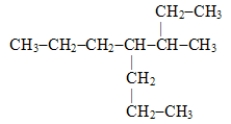Multiple Choice
The systematic name for the compound represented below is 
A) 4,5-diethylheptane
B) 3-propyl-4-ethylhexane
C) 3-ethyl-4-propylhexane
D) 3-methyl-4-propylheptane
E) 2-ethyl-4-propylhexane
Correct Answer:

Verified
Correct Answer:
Verified
Q2: Which type of organic compound does not
Q3: Oxidation of the 2-propanol will produce a/an<br>A)
Q34: Which of these reactions leads to a
Q38: A particular structural isomer of C<sub>6</sub>H<sub>14</sub> is
Q39: The formula CH<sub>3</sub>C <span class="ql-formula" data-value="\equiv"><span
Q40: Which one of these structures represents an
Q48: Name the following compound: <img src="https://d2lvgg3v3hfg70.cloudfront.net/TB3246/.jpg" alt="Name
Q51: Which option represents 1,6-hexanediamine<br>A) HNCH<sub>2</sub>CH<sub>2</sub>CH<sub>2</sub>CH<sub>2</sub>CH<sub>2</sub>CH<sub>2</sub>NH<br>B) H<sub>2</sub>NCH<sub>2</sub>CH<sub>2</sub>CH<sub>2</sub>CH<sub>2</sub>CH<sub>2</sub>CH<sub>2</sub>NH<sub>2</sub><br>C) H<sub>2</sub>NC(NH<sub>2</sub>)CH<sub>2</sub>CH<sub>2</sub>CH<sub>2</sub>CH<sub>2</sub>CH<sub>3</sub><br>D)
Q53: Select the one chiral molecule.<br>A) CH<sub>2</sub>Cl<sub>2</sub><br>B) CHFClBr<br>C)
Q55: Esters are synthesized from two classes of